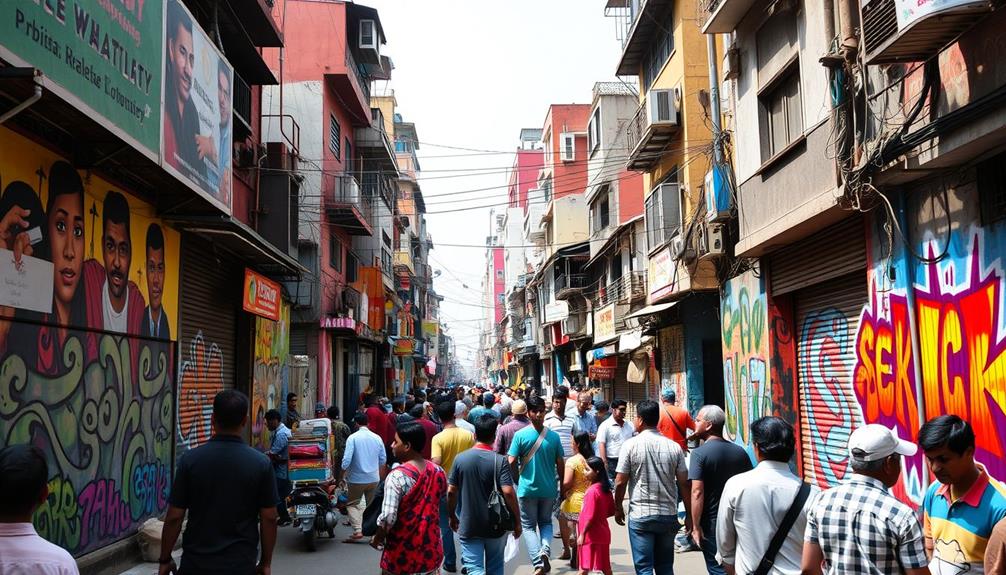When exploring the Santhal School of Painting, you'll connect with a vibrant cultural legacy that spans over 1500 years. This art form beautifully portrays community life, nature, and significant rituals, from harvests to marriage celebrations. Artists use natural colors and traditional techniques, creating pieces that resonate with storytelling. You'll notice regional variations, each reflecting unique styles and themes. In contemporary settings, Santhal art thrives through modern adaptations and collaborations, elevating its visibility. If you want to understand the intricate techniques and socio-cultural importance of this compelling art, there's much more waiting for you to discover.
Key Takeaways
- The Santhal School of Painting reflects over 1500 years of cultural heritage, emphasizing community rituals and agricultural life in Jharkhand and West Bengal.
- Vibrant colors and geometric patterns characterize Santhal art, often depicting traditional themes like dance, harvest, and familial celebrations.
- Natural colors from plants and minerals are traditionally used, while modern artists increasingly adopt acrylic paints for broader accessibility.
- Workshops and collaborations with NGOs are essential for preserving techniques and supporting local artisans in adapting to contemporary challenges.
- Contemporary exhibitions and cross-cultural projects enhance visibility and appreciation for Santhal art, integrating traditional motifs into modern narratives.
Historical Context of Santhal Art
The Santhal School of Painting has deep roots in the cultural heritage of the Santhal tribe, which has flourished for over 1500 years across regions like Jharkhand and West Bengal. This tribal art reflects the tribe's deep connection to nature and the community, encapsulating their history and cultural importance.
You'll find that Santhal paintings often portray scenes of dance, harvest, and marriage celebrations, which are essential to their social fabric. The lively representation of these themes creates an engaging narrative that resonates with the community's values and traditions, similar to how reviving old friendships often involves reconnecting over shared experiences.
During the 1930s, Rabindranath Tagore's establishment of an artists' colony in Santiniketan greatly boosted the visibility of Santhal art. Influential artists like Nandalal Basu and Ramkinkar Baij played critical roles in promoting these traditional forms.
Furthermore, the art saw a revival during India's freedom movement, where its ancient roots and storytelling elements were emphasized. Artists like Jamini Roy incorporated myths and nature into their work, showcasing the enduring themes of Santhal culture.
Over time, Santhal paintings evolved from the traditional scrolls made with organic colors to contemporary formats using synthetic materials. Regardless of these changes, the cultural importance and narrative depth remain integral to this vibrant art form, connecting generations through shared heritage.
Key Themes in Santhal Paintings

Key themes in Santhal paintings vividly capture the essence of community life and cultural practices. You'll notice how these tribal art pieces highlight rituals, festivals, and agricultural activities, showcasing the Santhal tribe's deep connection to their heritage. Common motifs like trees, flowers, and animals appear in simplistic forms, emphasizing artistic expression over strict realism.
Celebratory themes stand out, particularly in marriage scenes, where the bride and groom are depicted in a doli, symbolizing the importance of family and social bonds. These artworks also illustrate strong human-animal relationships, reflecting the tribe's agrarian lifestyle and reliance on nature for sustenance.
To better understand these themes, consider the following table:
| Theme | Description |
|---|---|
| Community Rituals | Depictions of festivals and ceremonies |
| Agricultural Life | Scenes of farming and harvest |
| Celebratory Events | Marriage and family gatherings |
| Nature Relationships | Interaction between humans and wildlife |
Through vibrant, often unrealistic colors, Santhal paintings convey dramatic storytelling, typically organized in horizontal bands to narrate events and themes.
Techniques and Materials Used

Exploring the techniques and materials used in Santhal painting reveals a rich tapestry of creativity and tradition. Here are some key aspects you'll find intriguing:
- Natural Colours: Vibrant hues are primarily derived from plants and minerals, preserving the authenticity of tribal art. This practice mirrors the use of essential oils for hair growth in wellness, where natural ingredients are prioritized for their benefits.
- Acrylic Paints: While older artists lean towards natural colours, modern artists often opt for acrylic paints, especially for exhibitions.
- Handmade Brushes: Artists create detailed work using brushes made from twigs or hair, adding a personal touch to their paintings.
- Geometric Patterns: Intricate patterns and motifs dominate the artworks, showcasing figures on a flat plane through freehand techniques.
The versatility of Santhal paintings is evident as they can be created on handmade paper, walls, floors, and cloth.
To maintain the vibrancy of their paintings, artists aim for an opaque paint consistency, avoiding excessive water that could dilute their colors.
Black strokes, often applied with bamboo sticks, highlight the boldness of their designs, bringing the stories to life.
This blend of traditional methods and materials makes Santhal art a unique and engaging form of expression.
Regional Variations of Santhal Art

When you explore the regional variations of Santhal art, you'll notice how Kalighat paintings burst with vibrant colors and dynamic figures, capturing lively daily scenes.
This lively style contrasts with the modern farmhouse decor trends that emphasize natural materials and neutral palettes.
In contrast, Midnapore's styles focus on delicate lines and elongated faces, often telling detailed stories through a more subdued palette.
These differences not only showcase unique artistic techniques but also reflect the rich cultural influences of each region's Santhal community.
Kalighat Painting Characteristics
Kalighat paintings stand out with their bold colors and dynamic figures, vividly bringing to life scenes from daily life and folklore. This unique style offers a fascinating glimpse into the Santhal community's cultural beliefs and artistic expressions, much like how philosophical texts can reveal deeper insights into human thought and behavior explores philosophical literature.
Here are some defining characteristics:
- Bold Colors: The use of vibrant and contrasting palettes emphasizes the energy and liveliness of the artwork.
- Exaggerated Features: Artists often employ dramatic interpretations with exaggerated facial expressions and elongated forms, enhancing the emotional depth.
- Thematic Diversity: These paintings frequently depict religious and mythological narratives, reflecting the spiritual essence of the Santhal heritage.
- Freehand Technique: The spontaneous and creative approach allows artists to capture characters and events with a sense of immediacy.
Kalighat paintings are more than just art; they're a powerful medium of storytelling.
You'll notice how the strong outlines and dynamic compositions create scenes that resonate with the viewer. Each piece not only communicates a visual story but also serves as a reflection of the cultural beliefs and practices that shape the Santhal community.
Midnapore Artistic Features
Midnapore's artistic features offer a fascinating contrast to other regional styles of Santhal art, showcasing a unique aesthetic that stands out through its finer lines and detailed themes. In Midnapore, Santhal paintings often emphasize intricate designs with a more subdued color palette, setting them apart from the vibrant hues typically found in Kalighat art. This variation in style reflects the deep cultural significance of community representation, similar to the way Aboriginal villages reflect traditional living.
You'll notice that the facial features in these paintings are often elongated, creating a distinct visual identity that reflects the cultural essence of the Santhal community.
The subjects depicted in Midnapore tribal art frequently revolve around daily life and nature, with each piece telling a story through its detailed themes. Artists focus on conveying narratives, making every brushstroke significant. This approach not only preserves traditional motifs but also allows for an evolution of style, maintaining the cultural identity of the Santhal people.
As you explore Midnapore's Santhal paintings, you'll appreciate how they encapsulate the community's spirit while showcasing the skill and creativity of the artists. This regional variation enriches the broader tapestry of Santhal art, inviting you to investigate deeper into its unique characteristics.
Regional Cultural Influences
Santhal art is a vibrant tapestry woven from the diverse cultural threads of various regions, each contributing its unique flavor to the overall style. This rich tribal art reflects the essence of tribal life across different landscapes, similar to how BPD-coded characters express complex emotional experiences.
Here are some key regional variations in Santhal paintings:
- Kalighat Style: Known for bold colors and dynamic figures, capturing the energy of local rituals.
- Midnapore Style: Features finer lines and elongated facial features, often narrating intricate stories.
- Jharkhand Influence: Uses natural colors and materials, emphasizing themes of community life and nature.
- Purulia's Patuas: This community preserves unique motifs and local myths, enriching the storytelling aspect of their artwork.
These regional variations not only highlight the artisans' connection to their environments but also embody the cultural significance and practices of their communities.
The vibrant color application and distinct themes in Santal paintings resonate with local flora and traditions, showcasing the diversity within this art form.
Cultural Importance and Significance

Art forms a vital part of the Santhal tribe's cultural identity, showcasing their traditions, rituals, and communal life through vibrant imagery and storytelling. For the tribal people, these paintings go beyond mere decoration; they serve as a spiritual tool, often used during festivals and rituals to invoke blessings from deities like Thakurjiu and Maranburu. This connection to the divine is deeply intertwined with their traditional practices, reinforcing their beliefs and values.
The Santhal art style, much like the beauty in imperfections, transforms everyday experiences into enchanting narratives that resonate with their cultural heritage. Santhal art captures essential themes such as agricultural practices, dance, and family celebrations, preserving oral histories that strengthen community bonds among the Santhal people.
With over 1500 years of continuity, these paintings embody a rich artistic heritage that remains culturally significant. While adapting to modern influences, they still reflect the essence of Santhal life and identity.
Moreover, the revival and promotion of Santhal art in contemporary settings not only sustains traditional practices but also provides economic opportunities for local artisans. This guarantees the preservation of their cultural legacy, allowing future generations to experience and appreciate the profound significance of these vibrant art forms in their lives.
Contemporary Adaptations and Influence

Today, you'll see how contemporary Santhal artists are reshaping their craft by embracing modern artistic expressions and collaborating across cultures.
This evolution mirrors the way various food movements, such as vegan food options, are adapting to contemporary tastes while honoring traditional roots.
These innovations not only keep traditional themes alive but also promote sustainable practices in art.
As you explore this evolution, you'll discover how Santhal painting continues to thrive in today's creative landscape.
Modern Artistic Expressions
Numerous contemporary artists are redefining Santhal painting by infusing it with modern techniques and themes. This evolution showcases how traditional art forms can thrive in today's artistic landscape.
For instance, artists are increasingly recognizing the emotional depth in their work, akin to how cats exhibit signs of attachment similar to dogs.
Here are some key aspects of these modern artistic expressions:
- Use of Acrylics: Artists are opting for acrylic paints instead of traditional natural colors, making their work more accessible to wider audiences.
- Blending Themes: Many contemporary Santhal artists weave traditional themes into modern narratives, addressing current social issues while maintaining the vibrant style.
- Collaborations: Partnerships between Santhal artists and designers have led to the integration of Santhal motifs in fashion and home décor, bridging the gap between traditional craftsmanship and modern aesthetics.
- Recognition and Workshops: Santhal paintings are gaining recognition in art circles through exhibitions, and NGOs are conducting workshops to guarantee the sustainability of this rich heritage.
Cross-Cultural Collaborations
Cross-cultural collaborations are breathing new life into Santhal painting, as artists from diverse backgrounds join forces to create innovative works that honor tradition while embracing modernity. These partnerships expand the horizons of tribal art, allowing Santhal motifs to find their way into contemporary fashion and home decor.
| Collaboration Type | Description | Impact on Santhal Art |
|---|---|---|
| Workshops | NGOs teach traditional techniques to new artists | Encourages evolution and adaptation |
| Fashion Partnerships | Designers incorporate Santhal motifs into clothing | Broadens audience appreciation |
| Digital Art Projects | Artists use vibrant Santhal colors in animations | Inspires new storytelling methods |
| International Exhibitions | Santhal art showcased globally | Fosters dialogue about indigenous art |
Sustainable Practices in Art
Sustainable practices in contemporary Santhal art are gaining momentum as artists embrace eco-friendly methods that honor their heritage.
This movement is reminiscent of the importance of digital creativity in modern parenting, where innovative approaches are being sought to blend tradition with contemporary values.
You'll find that these artists aren't only preserving traditional methods but also minimizing their environmental impact.
Here are a few key aspects shaping this movement:
- Natural Colors: Artists source colors from plants and minerals, staying true to their roots.
- Workshops: Training programs educate new artists on eco-friendly materials, ensuring sustainable practices continue.
- Modern Integration: The fusion of traditional Santhal art with contemporary design promotes ethical sourcing and production methods.
- Collaboration with NGOs: Partnerships focus on documenting and promoting sustainable art, enhancing community engagement.
Preservation Efforts and Challenges

As the world rapidly modernizes, the preservation of Santhal painting faces significant challenges, but various efforts are underway to safeguard this rich cultural heritage. Workshops and training programs aim to educate new artists about traditional techniques and the cultural significance of this vibrant art form.
NGOs and government initiatives are providing vital resources and support to local artisans, addressing the obstacles posed by modernization.
Despite these preservation efforts, limited access to materials and economic opportunities continues to hinder the sustainability of Santhal art. There's a growing call for greater community and governmental support to guarantee that artists can thrive.
Additionally, integrating Santhal art into modern exhibitions and collaborating with artists from diverse backgrounds has increased awareness and appreciation, further aiding preservation.
Documentation projects are also in progress to record traditional Santhal painting techniques and themes. By ensuring this knowledge is preserved, these initiatives help maintain the continuity of this cultural heritage amidst changing societal dynamics.
Through these combined efforts, the future of Santhal painting looks promising, but ongoing commitment is essential to overcome the challenges that lie ahead.
Frequently Asked Questions
What Are the Characteristics of Santhal Paintings?
Santhal paintings showcase vibrant colors, simple imagery, and dynamic compositions. You'll notice figures in profile with exaggerated features, emphasizing emotions. Geometric patterns and handmade tools highlight the community's cultural practices and artistic expression.
Which School of Painting Was Known as Indian?
When you think of the distinguished lineage of Indian painting, the illustrious traditions of the Bengal School immediately come to mind. Its enchanting blend of modernity and heritage truly encapsulates the essence of Indian artistic expression.
Which Is the Name of the Famous School of Painting in Himachal Pradesh?
The famous school of painting in Himachal Pradesh is the Guler School. It emerged in the 18th century, showcasing intricate details and vibrant colors, often depicting themes from Hindu mythology and daily life.
Which Is the Most Prominent Center of Western Indian School of Painting?
The most prominent center of the Western Indian School of Painting is Maharashtra. You'll find its Warli and Paithani styles enchanting, showcasing daily life and vibrant silk sarees, reflecting the region's rich cultural heritage.
Conclusion
In exploring the Santhal school of painting, you've uncovered a treasure trove of vibrant history and culture that bursts with life! The colors and stories leap off the canvas, as if the very spirits of the Santhal people are dancing before your eyes. These artworks aren't just paintings; they're powerful expressions of identity that shatter the mundane and ignite your imagination. If you don't immerse yourself in this art, you're missing out on a cosmic explosion of creativity!









